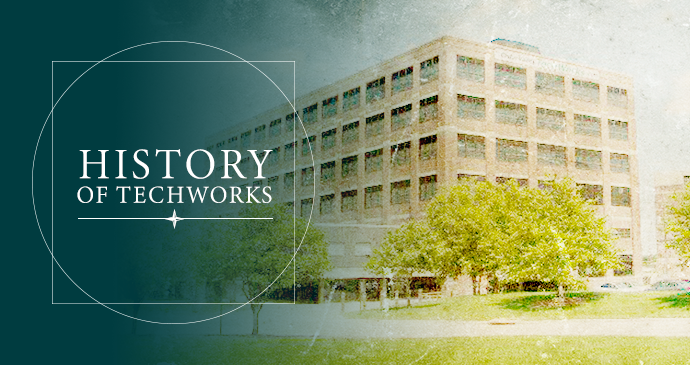
Reflection on History of Innovation
Lincoln Savings Bank recently announced the purchase of the top three floors of the historic John Deere Tractor Company R Building located on TechWorks campus in downtown Waterloo. As we look towards the future, we’d like to take a moment to reflect on the history of innovation the tractor building and TechWorks campus represent.
1880-1920
For nearly a century, the City of Waterloo has been a hub for the farming industry through the ebb and flow of the agricultural industry. In 1882, John Froelich and a group of businessmen created the first-ever gasoline-powered tractor for their fresh new company, the Waterloo Gasoline Traction Engine Company. While this initial design didn’t prove successful, it paved the way for future gasoline and kerosene powered tractors years later.
In 1918, Deere & Company, today known as John Deere Tractor Company, purchased Waterloo Gasoline Engine Company for $2,100,000, cementing them in the Waterloo history books.
Upon their purchase of the initial Waterloo Gasoline Engine Company’s manufacturing facilities, Deere & Company saw an immediate opportunity for expansion. Less than a decade later, the business’s board of directors voted to invest $3.9 million in the expansion of the Waterloo manufacturing facilities to increase the production of their GP or General-Purpose model intended to be used for multiple farm-related functions.
1920-1950
In April of 1928, the town of Waterloo began to start preparing for the influx of people, jobs, and economic growth. The Waterloo Evening Courier described the expansion announcement as, “the greatest industrial development in the history of Waterloo.” The initiative by Deere & Company was projected to add nearly 10,000 people to the city’s population within two years.
The pinnacle of Deere & Company’s expansion efforts centered around a “front-door” building for the manufacturing complex. Tractor Building R would be the first six-story building in the city, and the spotlight of success for the new manufacturing facilities. In December of 1928, the Waterloo Evening Courier ran the headline, “Tractor Company Expansion is Boom to the Whole Community,” along with illustrations of the new facilities to come.
Upon completion of the R Building, managers allowed tours of the new space in operation for reporters of the community. One such journalist referred to the R building’s third floor as the ‘machine and equipment hospital.’ In this area, workers would repair machinery and conduct routine maintenance to keep things operating smoothly. The reported continued describing the new structure while exploring the sixth floor, “Our guide takes us first to the sixth floor, where we find row upon row of machines looking as if they were all making the same thing. [Gears] It is a revelation to us just to stand there and watch row after row of machines doing their work as if they were human and highly educated in a place of just cold iron and steel.”
Astounded by the complexities of the manufacturing industry, the reporter further shared his surprise of the working conditions within the plant as well. “The men that are working in this department do not seem to be hurried, as their principal duty is to supervise the operation of these machines and see that they were supplied with fresh material from time to time.”
1950-1970
At the peak of Deere’s production, the R building was an integral piece of the plant’s vertical production process. Deere & Company built the C2 Building to expand its production line and continue its extended growth in the industry. Within the C2 Building Deere & Company employees would assemble smaller parts into larger portions, ultimately piecing together the iconic green and yellow machinery we still recognize today.
In the 1970s, Deere & Company shifted their production efforts to more horizontal strategies and moved their productions toward Donald St. and near the northeastern edge of the city.
Today
The R and C2 buildings both still stand today, with the backdrop of John Deere’s new manufacturing facility in the distance. The C2 Building has been granted historical significance and opened in 2017 as the Courtyard Marriot Hotel at TechWorks. In 2019, the Blue Iguana Restaurant and Iron Horse Bar both opened their doors within the hotel as well.
The R building, colloquially known as TechWorks, currently houses Grow Cedar Valley, the Cedar Valley Makerspace, Iowa Advanced Manufacturing Network Hub, Productive Resources, and the UNI Additive Manufacturing & Design Center.
The Future
Lincoln Savings Bank is honored to be part of the newly forming Waterloo history while showing reverence for the century of memories the building holds. “The historic John Deere building is an ideal location for our team and will also bring jobs to downtown Waterloo. We are proud to continue the long history of economic development within this building and are eager to get started on this project,” Erik Skovgard, President and CEO commented.
The former tractor building has so much history and character. Lincoln Savings Bank is excited to breathe life back into the building while keeping the historic integrity.
- Full interior renovation of 5th and 6th floors for LSB office space
- Combination of private offices and open work stations designed to embrace historic elements of the building
- A vibrant variety of shared support spaces supporting the needs of a modern business environment
- Restoration of the historic window patterns
- Interior concrete column structure will be a feature of 4th and 5th floors
- Roof truss structure and renovated roof light monitor will be a feature of the 6th-floor office
- Exterior masonry repair
- Roof replacement
- Entrance canopy
Do you have stories to tell?
Do you, your family or friends have ties to Waterloo Gasoline Traction Engine Company or John Deere? Please fill out the form below if you would like to share your stories with those around the Cedar Valley community.



